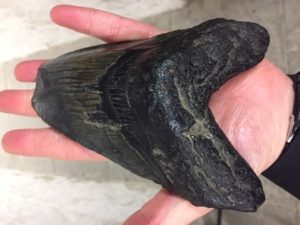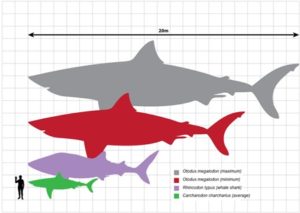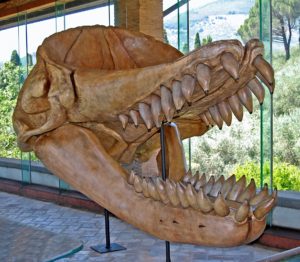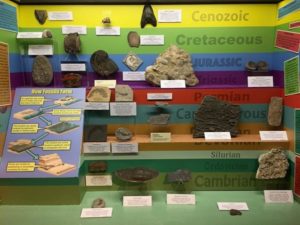Today’s blog is has been written by Dr Gearóid Mac a’ Ghobhainn, Collections Curator at Bradford Museums & Art Galleries, on the subject of the ‘Meg’ – the largest known shark to have ever lived on earth and subject of many a Hollywood film.
During Covid-19 lockdown. Your wonderful museums with all your glorious treasures have had to remain closed to help prevent the spread of this particularly dangerous SARS virus. To give some respite I hope this short blog on a particularly toothy treasure helps fill this gap in your heritage needs.
An interesting specimen from the Geology Collection, specifically from the Vertebrate Palaeontology section, is a rather large fossil tooth. This particular tooth is from an ancient shark unfortunately no longer with us. It belonged to the largest known shark to have ever lived on Earth, Otodus* megalodon. Commonly just called Megalodon. (Mega = big and odon = tooth), or the very informal Meg.
This particular specimen, NS.49.76, comes from the Miocene rocks of County Durham. In geological terms the Miocene is not that long ago; from 23 million years ago until only 5.33 MYA. Fortunately, or not, no modern humans ever met with this huge shark since the earliest modern human is estimated to be from only 200-250,000 years ago.

Ancient Seas
Sharks have been in Earth’s oceans for hundreds of millions of years. The oldest fossil shark teeth date to the early Devonian Period (the Age of Fishes) more than 400 MYA. However, these very early sharks look quite different from modern sharks. It was during the following period, the Carboniferous (359-299 MYA), when sharks diversified greatly and were prominent predators in all the world’s oceans and seas that the typical shark appearance can be seen. One of the most well-known is Cladoselache from about 370 MYA.

In the late Devonian period sharks would have shared the oceans with the great armoured fishes, the Placoderms. One of the most ferocious of these was Dunkleosteus terrelli, which could reach almost 9 m long and weighed in at around 4 tonnes.

Most sharks that lived between 350 and 150 million years ago can be placed in two large groups; the Xenacanthidae, fresh water sharks that became extinct at the mass extinction at the end of the Permian 250 MYA, or the hybodonts that first appeared around 320 MYA. These were primarily marine but had a few freshwater forms.
Modern sharks can be traced back to a common ancestor that inhabited the oceans about 100 MYA in the early Cretaceous period.

Size Matters
The Megalodon sharks could grow up to 18 m long and weigh up to 60 tonnes. However, a recent 2019 study, using Great White (Carcharodon sp) shark proportions as a correlation, suggests a more conservative 15.3 m long as more typical (Shimada, 2019). Male Megalodons are estimated to have been slightly smaller at 12.5 m long and 40 tonnes. The largest estimates are the equivalent of two buses long and the combined weight two and a half African bull elephants (6.5 tonnes each), not the skinny Indian elephants (a measly 5 tonnes). It is estimated that these giant sharks could have swum up to 11 km/hour.

The teeth of the Meg can reach 18 cm or 7.1 inches in old money. They are the largest known shark teeth. Reconstructions suggest a tooth formula of: 2.1.7.4 top row and 3.0.8.4 bottom row with five rows of teeth in a 2-metre wide mouth of over 250 teeth. Very bitey. They had a similar number of teeth to today’s Great White shark. The Great White teeth are, however, significantly smaller at less than half the size of Megalodon.

In modern oceans, the largest shark is famously the Great White, Carcharodon carcharias, once thought to be closely related to Meg based on superficial characters of their teeth. Recent studies suggest that Meg is a member of the Otodontidae family of sharks and the Great White belongs to the Lamnidae family, their sister group. Great Whites have been around for over 16 million years so would have swum in oceans inhabited by Meg. Megalodon is thought to have become extinct around 3.5 to 4 MYA.
Food for thought
Megalodon has been shown to have been an apex predator, higher even than the Great White. Due to its sheer size and power, the Meg was able to feed on cetaceans such as dolphins and smaller whales like bowheads, sperms and rorquals and the extinct cetothere whales and squalodontids (shark-toothed dolphins). During the Miocene, they would have faced competition for food from other huge whale hunting sea creatures like Livyatan a cetacean hunting sperm whale, and the squalodontids.

Some recent studies have suggested that Megalodon gradually became extinct due a combination of factors including cooling oceans, a change in the habits of their favoured food source the baleen whales, which began to favour colder polar waters, a reduction in diversity of their prey (a number of baleen whale species became extinct). With these changing environmental factors driving evolution and behavioural changes Megalodon would have switched prey to those found in warmer waters and thus would have faced increased competition with the smaller Great White that was more expert in hunting the smaller prey.
The Megalodon fossil tooth is on display in the Understanding Fossils case in the Airedale Gallery at Cliffe Castle Museum, Keighley. Come visit your museum once we reopen after lockdown. Dates and times of opening will be posted online when we are ready to reopen.

* N.B. The genus name of Megalodon is disputed. Some prefer to use Otodus while others use Carcharocles. The older Carcharodon has dropped out of use by all serious shark enthusiasts since it is assigned to white sharks from a different family. As currently defined I have used the Otodus genus name as the most recent published articles of 2019 and 2020 have favoured this name.
Refs
Shimada Kenshu. The size of the megatooth shark, Otodus megalodon (Lamniformes: Otodontidae), revisited. Historical Biology 1-8 (2019)